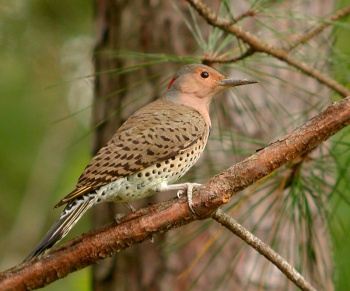- Colaptes auratus
Identification
30–35 cm (11¾-13¾ in)
- Brown with black bars on the back and wings.
- Beige breast and belly with black spots
- black "necklace"
- Dark tail, white rump
- Black moustachial stripe in male
There are two forms which were formerly considered separate species:
"Yellow-shafted" Flicker
Resides in eastern North America.
- Yellow under the tail and underwings and have yellow shafts on primaries
- Grey cap, beige face
- Red bar on their neck.
"Red-shafted" Flicker
Resides in western North America.
- Red under the tail and underwings and have red shafts on their primaries.
- Beige cap, a grey face
- Red mustache
These two forms interbreed where their ranges overlap.
Distribution
It is native to most of North America and parts of Central America. Northern birds migrate to the southern parts of the range; southern birds are often permanent residents.
Taxonomy
Guatemalan Flicker was formerly included in Northern Flicker. The yellow-shafted and red-shafted forms have been considered separate species in the past.
Subspecies
Clements recognizes these subspecies[1]:
- C. a. chrysocaulosus: Cuba
- C. a. gundlachi: Grand Cayman Island
Northern Flicker (Yellow-shafted)
- C. a. luteus: Central Alaska to southern Labrador, Newfoundland, Montana and north-eastern US
- C. a. auratus: South-eastern US
Northern Flicker (Red-shafted)
- C. a. cafer: Southern Alaska and British Columbia to northern California
- C. a. collaris: South-western US to north-western Baja and western Mexico (Durango)
- C. a. rufipileus: Formerly Guadalupe Island, Mexico. Extinct; last recorded 1906.
- C. a. mexicanus: central Mexico, from Nayarit and Durango east to Veracruz, south to Oaxaca
- C. a. nanus: southwestern United States (Chisos Mountains, Texas) and northeastern Mexico (Coahuila to Tamaulipas, south to San Luis Potosí)
Habitat
Their breeding habitat is forested areas across North America, as far south as Central America. Also suburban areas
Behaviour
Flight
Like many woodpeckers, its flight is undulating. The repeated cycle of a quick succession of flaps followed by a pause creates an effect comparable to a rollercoaster.
Diet
Flickers feed by probing with their bill, also sometimes catching insects in flight. Although they eat fruits, berries, seeds and nuts, their primary food is insects. Ants alone can make up 45% of their diet. They have a behavior called anting, during which they use the acid from the ants to assist in preening, as it is useful in keeping them free of parasites.
Breeding
It takes about 1 to 2 weeks to build the nest which is built by both sexes of the mating pairs. Damaged nests or previously abandoned cavities may be repaired. The entrance hole is roughly 5 cm to 10 cm wide. Flickers will sometimes be willing to use a birdhouse if it is adequately sized and properly situated. They nest in a cavity in a tree or post; this bird excavates its own home. Abandoned flicker nests create habitat for other cavity nesters. They are sometimes driven from nesting sites by European Starlings.
Typically 6 to 8 eggs are laid, having a shell that is pure white with a smooth surface and high gloss. The eggs are the second largest of the North American woodpecker species, exceeded only by the Pileated Woodpecker's. Incubation is by both sexes for approximately 11 to 12 days. The young are fed by regurgitation and leave the nest about 25 to 28 days after hatching.
Vocalisation
This bird's call is a sustained laugh, ki ki ki ki ..., more congenial than that of the Pileated Woodpecker. You could also hear a constant knocking as they often drum on trees or even metal objects to declare territory.
Gallery
Click on photo for larger image
Red-shafted
Photo © by marcsantacurz
Hawk Hill, Marin Headlands, California, 23 September 2018Intergrade
Photo © by ducbucln
Clear Lake State Park, Kelseyville, California, 15 October 2015
References
- Clements, J. F., P. C. Rasmussen, T. S. Schulenberg, M. J. Iliff, T. A. Fredericks, J. A. Gerbracht, D. Lepage, A. Spencer, S. M. Billerman, B. L. Sullivan, M. Smith, and C. L. Wood. 2024. The eBird/Clements checklist of Birds of the World: v2024. Downloaded from https://www.birds.cornell.edu/clementschecklist/download/
- Gill, F, D Donsker, and P Rasmussen (Eds). 2024. IOC World Bird List (v 14.2). Doi 10.14344/IOC.ML.14.2. http://www.worldbirdnames.org/
- Wiebe, K. L. and W. S. Moore (2020). Northern Flicker (Colaptes auratus), version 1.0. In Birds of the World (P. G. Rodewald, Editor). Cornell Lab of Ornithology, Ithaca, NY, USA. https://doi.org/10.2173/bow.norfli.01
- Wikipedia contributors. (2020, September 7). Northern flicker. In Wikipedia, The Free Encyclopedia. Retrieved 22:25, October 9, 2020, from https://en.wikipedia.org/w/index.php?title=Northern_flicker&oldid=977124535
- Cornell Lab of Ornithology. 2019. Northern_Flicker in: All About Birds. Cornell Lab of Ornithology, Ithaca, New York. https://www.allaboutbirds.org/ Accessed on 9 October 2020
Recommended Citation
- BirdForum Opus contributors. (2025) Northern Flicker. In: BirdForum, the forum for wild birds and birding. Retrieved 11 May 2025 from https://www.birdforum.net/opus/Northern_Flicker
External Links
GSearch checked for 2020 platform.1











